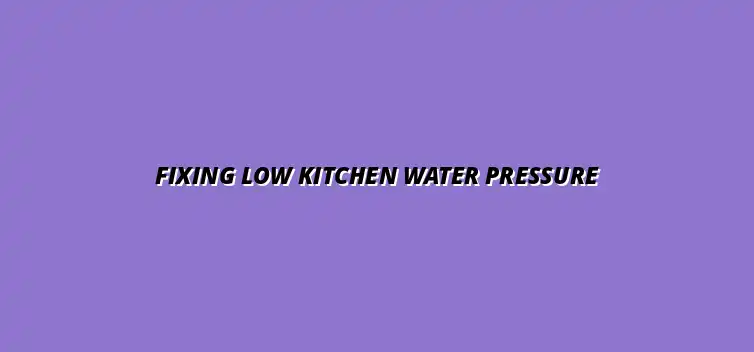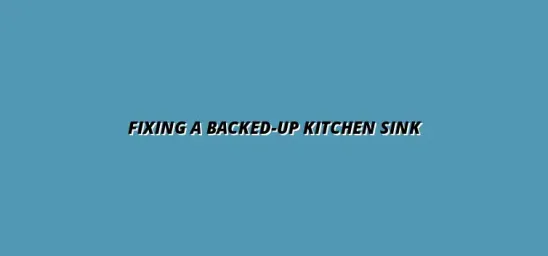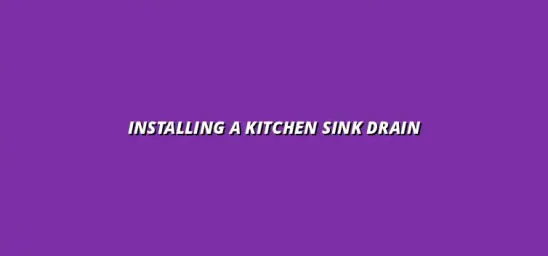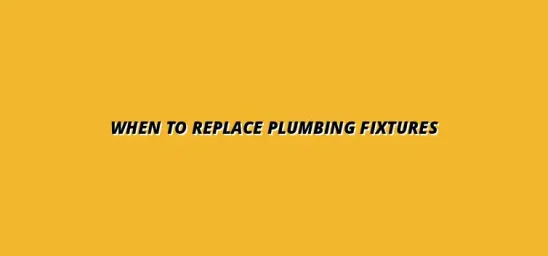
Fixing Low Kitchen Water Pressure
Understanding Low Water Pressure in the Kitchen
Low water pressure in the kitchen is when you don’t get enough water flowing through your taps. This can make daily tasks like washing dishes, cooking, and cleaning frustrating. When the water dribbles instead of rushing, chores take longer and can feel like a hassle!
Low water pressure can also affect how well your appliances work. For instance, if you're trying to fill a pot for pasta, a slow trickle can delay dinner. It's essential to understand low water pressure to tackle the issue effectively and ensure your kitchen runs smoothly. If you're facing persistent issues, consider checking out these plumbing maintenance tips for homeowners for preventative measures.
What is Low Water Pressure and Its Impact?
When we talk about low water pressure, we mean the amount of force with which water flows from taps. It can be a real annoyance during cooking or cleaning. Imagine trying to rinse off soap from dishes only to find that the water barely drips!
The impact of low water pressure extends beyond inconvenience. It can lead to longer cleaning times, inefficient cooking, and even affect the performance of appliances relying on steady water flow. Addressing this issue is crucial for maintaining a functional kitchen.
- Washing dishes becomes time-consuming.
- Cooking can get delayed.
- Some appliances may not work effectively.
Common Causes of Low Water Pressure in the Kitchen
Understanding what causes low water pressure is the first step to fixing it. Several common culprits can lead to this issue, and recognizing them can save you time and effort. Here are some typical causes:
- Clogs: Mineral buildup or debris in pipes can restrict water flow. Learn how to tackle kitchen drain blockages effectively.
- Leaks: Hidden leaks in the plumbing system can lead to lower pressure. A leaky kitchen sink is a common culprit.
- Municipal Supply Problems: Sometimes, the issue lies outside your home, with the water supply from the city.
By identifying these common causes, you can focus on the right troubleshooting steps. Each of these issues can affect your kitchen’s water pressure in different ways, so it’s essential to know what you’re dealing with.
Signs of Low Water Pressure
Recognizing the signs of low water pressure can help you act quickly. Noticing these indicators means you can address the issue before it becomes worse. Here are some signs to look out for:
- Weak water flow: If your faucet only dribbles, that's a clear sign.
- Uneven water flow: If some taps work fine while others don’t, it may indicate localized issues.
- Long fill times: If it takes too long to fill a pot or sink, low pressure might be the reason.
Being aware of these signs means you can take timely action. If you notice any of these issues, it’s a good idea to investigate further. For simple fixes, try these DIY tips to fix low water pressure.
Initial Troubleshooting Steps for Low Water Pressure
Once you understand low water pressure and its signs, it’s time to tackle the issue. Initial troubleshooting can often reveal the problem and help you restore your kitchen’s water flow. Here are some steps you can take to start troubleshooting:
Advanced Solutions for Persistent Low Water Pressure
Assessing the Plumbing System for Blockages
If you're still facing low water pressure after initial troubleshooting, it may be time to look deeper into your plumbing system. Over time, pipes can accumulate rust, debris, or mineral deposits that lead to blockages. These blockages can restrict water flow, making it essential to regularly assess the plumbing system.
To investigate for possible blockages, follow these steps:
- Turn off the water supply to your kitchen.
- Inspect visible pipes for signs of corrosion or buildup.
- Use a plumbing snake or auger to clear minor clogs.
- Consider flushing your plumbing system with vinegar or a commercial cleaner to dissolve buildup.
After you've cleared any blockages, turn the water supply back on and check if the pressure improves. If there's still no change, further investigation into your plumbing layout may be necessary. Sometimes, a specific area like your kitchen sink might require attention; learn how to fix kitchen sink water pressure effectively.
Evaluating Municipal Water Supply Issues
Sometimes, the problem extends beyond your home and lies within the municipal water supply. Factors such as construction, scheduled maintenance, or severe weather can affect water pressure in your area. Therefore, it's wise to stay informed about any external issues that might impact your kitchen's water flow.
To evaluate possible municipal supply issues, consider the following:
- Check with neighbors to see if they experience similar low water pressure.
- Contact your local water authority for updates on supply issues or maintenance schedules.
- Monitor your water pressure during peak usage times and compare it to off-peak times.
If external issues are confirmed, be patient! Municipal departments typically resolve these problems, but it may take some time. In the meantime, you can explore temporary solutions or alternatives for your water needs. Low water pressure can also impact your water heater; check out these tips on fixing low water pressure in heaters.
Considering Water Pressure Regulators
If you live in an area with fluctuating water pressure, installing a water pressure regulator may be a good solution. These devices help maintain a consistent water pressure level, preventing damage to your plumbing and appliances. They can be particularly useful if you often face high pressure that leads to leaks or other issues.
Before installing a water pressure regulator, assess the following points:
- Determine the current water pressure using a pressure gauge.
- Identify whether your home’s pressure fluctuates regularly.
- Consult a plumbing professional about the appropriate type of regulator for your system. For professional help in Birmingham, consider a plumber in Billesley, Birmingham.
Investing in a water pressure regulator can save you time and money by preventing potential plumbing problems down the line! If you're unsure how to install one, a professional plumber can assist you with the setup.
Frequently Asked Questions About Low Water Pressure in the Kitchen
What Should I Do If My Water Pressure is Low Only in the Kitchen?
If you notice that low water pressure is isolated to your kitchen, there are specific steps you can take to address the issue. Start with confirming that the problem is not affecting other areas of your home. If it’s limited to the kitchen, focus on these checks:
- Inspect the kitchen faucet aerator for clogs.
- Check the shut-off valves under the sink.
- Make sure there are no kinks in the supply hose.
By systematically investigating these elements, you can often pinpoint the source of low pressure and take corrective action.
Can Low Water Pressure Affect My Appliances?
Yes, low water pressure can significantly impact kitchen appliances that rely on a consistent water supply. Dishwashers, refrigerators with water dispensers, and even coffee machines can function poorly under low pressure. This can lead to inefficient cleaning, slower filling times, and potential damage over time.
Here are some ways low water pressure might affect your appliances:
- Dishwashers may not clean dishes thoroughly.
- Ice makers can produce smaller ice cubes or take longer to fill.
- Water dispensers may have reduced flow or fail to dispense water.
Addressing low water pressure can help ensure your appliances work effectively and last longer!
When to Call a Professional Plumber
If you've tried all of the DIY solutions and still struggle with low water pressure, it might be time to call in a professional. A plumber has the tools and expertise to identify issues that could be hidden from view and recommend the best course of action.
Consider reaching out to a plumber in the following situations:
- Persistent low water pressure despite troubleshooting steps.
- Visible signs of pipe damage or leaks.
- Complex plumbing issues that require specialized knowledge.
Getting a professional's help can save you time and give you peace of mind knowing that your plumbing system will be thoroughly addressed!
Summary and Next Steps
In conclusion, addressing low water pressure in your kitchen can involve a series of troubleshooting and advanced solutions. From assessing blockages in your plumbing system to evaluating municipal supply issues and considering the installation of regulators, there are multiple paths to restoring efficient water flow.
Taking proactive steps, such as regular maintenance and prompt attention to signs of low water pressure, will help maintain optimal performance in your kitchen. Don't hesitate to seek professional help if your efforts don't yield results — your kitchen deserves the best!





Fixing a Backed-Up Kitchen Sink
Prepare Your Plumbing for Weather
Installing a Kitchen Sink Drain
When to Replace Plumbing Fixtures
Fixing a Jammed Garbage Disposal